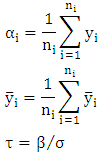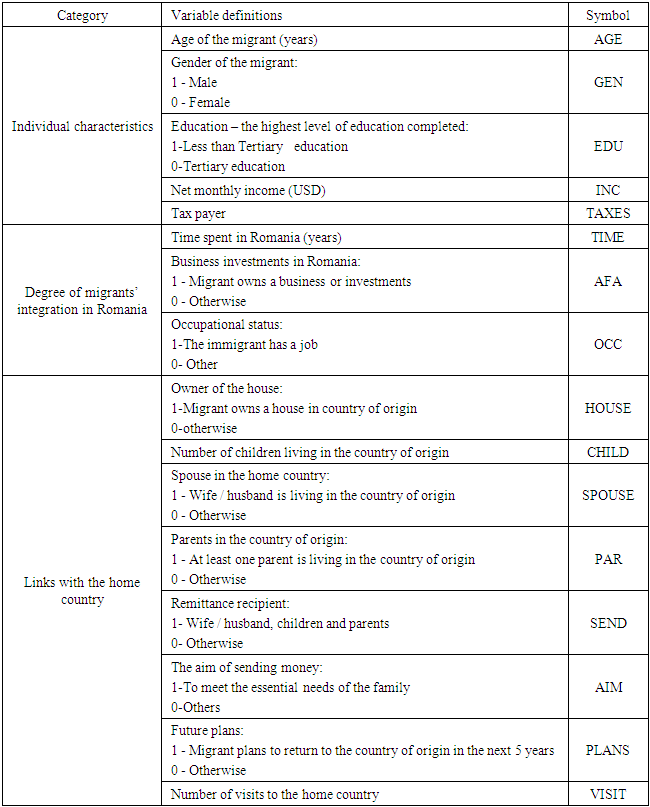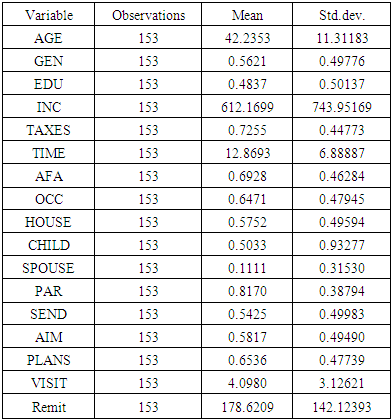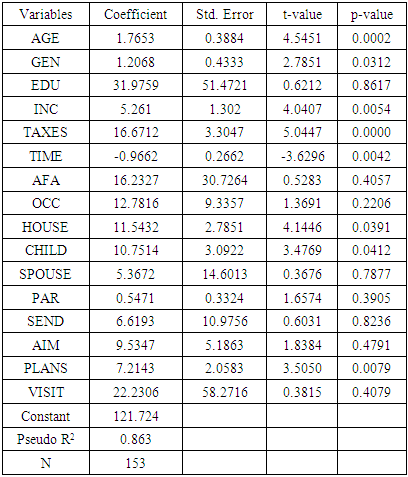-
Paper Information
- Next Paper
- Paper Submission
-
Journal Information
- About This Journal
- Editorial Board
- Current Issue
- Archive
- Author Guidelines
- Contact Us
International Journal of Statistics and Applications
p-ISSN: 2168-5193 e-ISSN: 2168-5215
2018; 8(2): 65-71
doi:10.5923/j.statistics.20180802.05

Asymptotic Least Squares Estimation of Tobit Regression Model. An Application in Remittances of Iraqi Immigrants in Romania
Meshal Harbi Odah
The Bucharest University of Economic Studies, Department of Statistics and Econometrics, Muthanna University, Iraq
Correspondence to: Meshal Harbi Odah, The Bucharest University of Economic Studies, Department of Statistics and Econometrics, Muthanna University, Iraq.
| Email: |  |
This work is licensed under the Creative Commons Attribution International License (CC BY).
http://creativecommons.org/licenses/by/4.0/

This paper proposes an alternative to maximum likelihood estimation of the Tobit regression model based on the method of moments which is suitable for repeated observers at first moments equal to zero as well as for cases containing censored observers at threshold point. This approach, called asymptotic least-squares (ALS) delivers strongly consistent and asymptotically normal estimates. It is shown that ALS can be used to obtain asymptotically efficient estimates for a large range of econometric problems. ALS is applied to the amount remitted by Iraqi immigrants in Romania to their home country demonstrating the potential of the method in the estimation of censored regression models. The study applies the Tobit regression model in order to reveal the most important factors affecting remittances sent and the best method to estimate data.
Keywords: Tobit regression, Asymptotic Least Squares, Remittances, International migration
Cite this paper: Meshal Harbi Odah, Asymptotic Least Squares Estimation of Tobit Regression Model. An Application in Remittances of Iraqi Immigrants in Romania, International Journal of Statistics and Applications, Vol. 8 No. 2, 2018, pp. 65-71. doi: 10.5923/j.statistics.20180802.05.
Article Outline
1. Introduction
- According to James Tobin’s research, the domestic income and spendings are in a statistical relationship. This relationship is particular, and it generally follows a linear model but at a certain value, data clustering occurs [21]. This value is the limiting value for the expenditures, which represent the dependent variable. The limiting value is censoring limit on the data where it clusters. This clustered data depicts the dependent variable information in a region, and it is does not produce a linear operation with a representation of a unique independent variable. As shown in the work of Wang [22], the application of the Tobit regression model is mostly suitable in dose-response analysis with censored and continuous result variable [4]. A biased model is produced in case of overlooking the censored data or in case the data is forced into a linear model. The use [19] Tobit regression model in the field of financial analysis (Iraqi Banks Loans), by providing empirical evidence about factors affecting in Iraqi Bank Loans, Formal studies have been scarce and mostly confined to OLS analysis, in spite of censored data with limited dependent variable at zero, shows that the bias can result when estimating bank loans using OLS if bank loans are censored. The Tobit model is the most suitable statistical model to solve the case in which a dependent variable is limited.International migration has become a widespread phenomenon and associated with this phenomenon are the financial practices of the migrants, which have impacted both the country of origin as well as the receiving country. The receiving countries are mainly concerned with the immigrants’ integration (social and economic), debated by economists and politicians. On the other hand, the countries of origin are also impacted by the financial behaviour of the migrants, as the remittances sent by the immigrants have become a source of external income for many of these countries. The impact of these funds can be estimated at country, regional or even household level by the amount of the international remittances, which have become constant financing sources for the families and friends of the immigrant workers. The first solid theoretical basis for explaining determinants of remittances was developed by [17]. They define two broad motives: altruism and self-interest. Pure altruism and pure self-interest are inadequate to explain variation in remittances, as often the migrant and the family left behind both benefit from migration through implicit contractual arrangements.The development literature has largely focused on the size and potential impact of migrants' remittances [1, 10]. In addition, a sizeable theoretical and empirical literature has revealed that a variety of motives may induce migrants to send remittances to their countries of origin [5-8, 15, 2].The study of Hagen-Zanker and Siegel [13] analysed the duration of the residence of migrants and how they affect the remittances to their country of origin and the relationship between migration and remittances because of their significant impact in the economies of countries that have a large proportion of migrants sending money to their original country.According to the World Bank [23], remittances in 2005 have exceeded US$ 233 billion worldwide. In comparison with $229 billion in 2002 and more than double the level recorded in 2001. Moreover, recorded remittances to developing countries have doubled between 2000 and 2005, indicating a substantial increase in payments of migrants to their families abroad. In 2007, remittances recorded by migrants from developing countries totalled $265 billion. During 2007, the top three recipients of remittances were India, China and Mexico, accounting for a total of more than US$77 billion in migrant transfers (worth almost a third of the remittances received by developing countries as a whole) [24]. In 2013, recorded remittance flows across international borders into developing economies exceeded US $410 Billion [25].The paper contributes to the existing literature in several respects. Firstly, empirical evidence on the determinants of Iraqi migrants' remittances is generated by examining data using Asymptotic Least Squares estimation of Tobit regression model alternative to maximum likelihood estimation of the Tobit regression model. While the major part of the existing literature on remittances mainly concentrates on migrants' transfers to developing countries, the analysis focuses on remittances of Iraqi migrants' in Romania to home country. Secondly, in addition to migrants' payments to family members in their countries of origin which are typically addressed by the literature on remittances, existing studies have often adopted more restrictive models for censored dependent variables to assess the determinants of Iraqi migrants' remittances.The paper is structured as follows: Section 2 Asymptotic Least Squares estimation of Tobit regression model; Section 3 The studied sample and data analysis; Section 4 Results and comments; Section 5 Conclusions.
2. Asymptotic Least Squares Estimation of Tobit Regression Model
- Since the use of econometric models with truncated or censored response variables has started to increase, it is important that the information they provide is fully and correctly used [14]. One of these models that has an increasing use is the Tobit regression analysis, a model devised by Tobin, in which it is assumed that the dependent variable has a number of its values clustered at a limited value, usually zero.Determine the threshold point for the social phenomenon of divorce, through a two-stage estimation model (Heckman) with Tobit regression, In order to obtain consistent estimates; the censoring threshold in divorce is zero. The difficulty is the determination of the threshold point in economic and social research and other phenomena where the limited dependent variable [18].In other words, the Tobit regression models are censored regression models where the threshold point that is considered is equal to zero. The Tobit technique uses all the observations, both those at the threshold and those above it, to estimate a regression line, and it is to be preferred, in general, over alternative techniques that estimate a line only with the observations above the threshold.Following the main methodological trends in recent literature, our empirical analysis Tobit regression model was applied in order to reveal the most important factors affecting remittances sent by Iraqi immigrants in Romania to their home country. In this model, the limited dependent variable because a Iraqi migrant sends money to the home country, the dependent variable is considered as quantity, if the immigrant does not send money, the dependent variable takes the value “zero”. The amount sent differs from one individual to another.The present work builds on a survey of 153 Iraqi immigrants in Romanian, resulting from our questionnaire survey conducted during June 22nd and October 3th 2017. In what follows, we understand the Tobit regression model the censored regression model through the functions of the model under the normality assumption. R Software also provides pseudo R squared based as in this paper when applying the Tobit model estimation. The Tobit regression model takes the following form:
 | (1) |
 | (2) |
 | (3) |
 Represents the latent variable and it is generated through traditional linear regression model according to the formula
Represents the latent variable and it is generated through traditional linear regression model according to the formula  it is non-observer when
it is non-observer when  It is sum of cash remittances sent by Iraqi immigrants in Romania, measured in USD.
It is sum of cash remittances sent by Iraqi immigrants in Romania, measured in USD. Is the random error; the set represents all the variables and is non-observed influencing in the dependent variable
Is the random error; the set represents all the variables and is non-observed influencing in the dependent variable  distributed
distributed  which i.i.d.
which i.i.d. Are the independent variable and the dependent variable each known;
Are the independent variable and the dependent variable each known;  ε: Represents the threshold point, the Tobit regression is performed on
ε: Represents the threshold point, the Tobit regression is performed on  by ε to inference the estimate. In our search the threshold point is equal to zero and represents immigrants who do not send money.To apply the Asymptotic Least Squares estimation of Tobit regression model, the following equation is used we use the method of moments that provides a useful approach in the case of censored observations [12]. The “zero” and first order moments of
by ε to inference the estimate. In our search the threshold point is equal to zero and represents immigrants who do not send money.To apply the Asymptotic Least Squares estimation of Tobit regression model, the following equation is used we use the method of moments that provides a useful approach in the case of censored observations [12]. The “zero” and first order moments of  are:
are: | (4) |
 | (5) |
 Thus, when n is sufficiently large, we have:
Thus, when n is sufficiently large, we have: | (6) |
 | (7) |
 through derivation in the matrix matching an easy-derivative
through derivation in the matrix matching an easy-derivative  that can be applied in the equation (7). Weighted least squares are used to obtain consistent estimates of the model [16]. The weighted least squares method is widely used in parameter estimates for consistent estimates, as well as for model estimations.The asymptotic covariance matrix of the error term is expressed by the asymptotic covariance matrix that contains the disturbance terms
that can be applied in the equation (7). Weighted least squares are used to obtain consistent estimates of the model [16]. The weighted least squares method is widely used in parameter estimates for consistent estimates, as well as for model estimations.The asymptotic covariance matrix of the error term is expressed by the asymptotic covariance matrix that contains the disturbance terms  where
where  The asymptotic correlation obtained is:
The asymptotic correlation obtained is: | (8) |
 represent the proportion of independent experiments conducted under environmental conditions
represent the proportion of independent experiments conducted under environmental conditions  The observations on the endogenous variables are:
The observations on the endogenous variables are: | (9) |
 | (10) |
 Where D is a column vector with elements
Where D is a column vector with elements 
3. The Studied Sample and Data Analysis
- Gathering accurate data on remittances is a difficult task both at the micro and macro level, as Iraqi official statistics supply not enough data is available. In order to obtain the necessary data on Iraqi immigrants in Romania. We conducted our survey through applying a questionnaire on 153 individuals, Iraqi immigrants in Romania, 61.4% of surveyed individuals being males and 38.6% females. The data were collected during the period from: between June 22nd and October 3th 2017. This questionnaire contains a set of questions. The survey was conducted on Iraqi immigrants in Romania based on 16 questions split into 3 sections. The questionnaire covered information about the migrants and their households, such as individual characteristics, degree of migrants’ integration in Romania, and links with the home country. In this way, the selection of the variables was inspired by the existing literature [20, 3]. We consider a similar distinction between the factors that describe the individual motivation to remit and therefore the variables taken into account were structured into the next three categories:(Ι) Individual factors: income, age, education, gender and tax payer;(ΙΙ) Factors that evaluate the degree of migrants’ integration in Romania: the length of stay in Romania, owning a business or having investments in Romania;(ΙΙΙ) Factors that evaluate the presence and intensity of the migrants’ links with the home country: number of visits, future plans with respect to remaining in Romania or not, parents, spouse and number of children living in the country of origin and owning a house in the country of birth. The explanatory variables (Table 1) representing potential factors that influence the remittance.
|
|
|
 greater than
greater than  at confidence level (0.01, 0.05).
at confidence level (0.01, 0.05).4. Results and Comments
- In this section, we present the results of running the regression model specified in the equation (10) using the questionnaire data on Iraqi emigrants in Romania. This method allows for the estimation of model Asymptotic Least Squares estimation coefficient of Tobit regression model. Using R package, the objective of our study is to determine the variables influencing remittances and to diagnose the factors clearly contributing to the increase of remit, through three categories of factors described above affect the propensity to remit. When analyzing the probability to remit, the results of the Tobit regression model are presented in Table (4).
|
5. Conclusions
- In this paper, remittances by Iraqi immigrants in Romania were estimated to their country of origin. The Tobit regression model was used with ALS method ALS to estimate the variables of the studied phenomenon because the dependent variable data is censored. The Tobit regression model has been applied instead of OLS so that we do not produce biased estimate were zero has been determined as a threshold point for the dependent variable and the censored point is the boundary of the data. It has been identified censored threshold point as zero: is if the immigrant does not send money, the dependent variable takes the value “zero”. Through the results of the analysis we were able to determine the most important variables affecting the migrant remittances. The results of the analysis show a high pseudo-R squared value of the interpretation and analysis of the results of the data that affect the identification of the most important variables in remittances. This means the Tobit model is an appropriate model to be applied on the phenomenon of remittances because not all migrants send money to their home country. In addition to table 3, we find that the value of the Fisher statistic is F=86.3 which also reinforces the fact that the analysis model is the best model in the analysis of remittances.The present research helps to recognize that migration and remittances play and important role in developing countries, helping to reduce poverty in some families as well as in the local economy. Considering that Iraq is a developing country, with a large share of the population affected by severe poverty in a was context, remittances are an important source for poverty alleviation and for providing the necessary resources for satisfying the basic needs.
 Abstract
Abstract Reference
Reference Full-Text PDF
Full-Text PDF Full-text HTML
Full-text HTML


